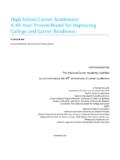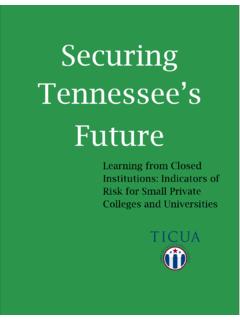Transcription of Identifying At-Risk Factors That Affect College …
1 83 International Journal of Process Education (June 2015, Volume 7 Issue 1) Identifying At-Risk Factors That Affect College Student SuccessJoann Horton1 AbstractAll too often, both traditional and non-traditional students face a variety of barriers to learning that put them at risk of failure in achieving their goals. This article explores twenty key Factors that impact student learning and success in College as identifi ed in research and practice. Understanding these key risk Factors provides a basis for educators to develop student learning skills to enable students to become profi cient in addressing their risk Factors and to achieve academic success.
2 This paper is intended not only to assist educators in Identifying critical risk Factors that students face, but also to propose addressing them through a holistic learning process that serves as a solid foundation for lifelong learning and Pacifi c CrestIntroductionSuccess in the 21st century requires a rigorous academic education, cutting-edge technical skills, and a foundation that supports continuous learning and growth for College , career, and life. It is important that students are taught how to learn and to address critical At-Risk Factors that might derail their dreams of College and career success.
3 Students who lack a foundation in knowing how to learn are closed out of signifi cant economic, academic, and social opportunities. In fact, lifelong learning is a major interest both nationally and globally (Cornford, 2002). The Manhattan Institute for Policy Research (Greene & Forster, 2003) estimated that nationally only 70% of all students in public high schools graduate and only 32% of all students leave high school qualifi ed (or College ready ) to attend four-year colleges. The authors specifi cally focused on the issue of public high school graduation and College readiness rates in the United States using Department of Education data.
4 The term College ready refers to applicants who pass the minimum requirements for College consideration: (1) graduation from high school, (2) completion of courses that colleges require for the acquisition of academic skills, and (3) demonstration of basic literacy skills. Far too many young people graduate from high school with big dreams for the future but without the solid academic foundation or learning skills they need to achieve them. The National Center for Educational Statistics in The Condition of Education (Kena et al.)
5 , 2014) states that the 2012 graduation rate for fi rst-time, full-time undergraduate students who began their pursuit of a bachelor s degree at a 4-year degree-granting institution in fall 2006 was 59 percent within six years, the normal time for completion (based on the requirements of the 1990 Student Right to Know Act). During the same period, data from the National Center for Educational Statistics (2006-2012) show that the student retention rate was for fi rst-time full-time students at all postsecondary institutions and for part-time students.
6 Without signifi cant change, the federal goal of having the world s highest rate of College completion by 2020 will not be achieved (Advisory Committee on Student Financial Assistance, 2012). Pathways to Success (2012), a report to the Congress and the Secretary of Education, states that the nation s global competiveness is threatened by stagnant or declining College completion rates. Income inequality, one of several high risk Factors , is impacting completion rates, particularly among young Americans and non-traditional students.
7 This paper identifi es several key high-risk Factors that impact fi rst-year College students and explores those behaviors within the context of non-cognitive success Factors . Lack of readiness for College places students at risk of failing courses and dropping out of College , temporarily or permanently, particularly during their fi rst year of enrollment. In addition, many students who are returning to school after an extended period of time due to other responsibilities, such as family and jobs, do not have the academic skills to navigate the educational landscape effectively.
8 There is much work to be done if higher education is to help students be FactorsWhat Are Risk Factors ?According to The Glossary of Education Reform, the term At-Risk is frequently used to describe individual students or groups of students who are considered to have a higher probability of failing academically or dropping out of school. The term may be applied to students who face circumstances or characteristics (fac-tors) that could jeopardize their ability to achieve aca-demic goals or complete school, such as homelessness, incarceration, teenage pregnancy, serious health issues, domestic violence, or transiency, or it may refer to learn-ing disabilities, low test scores, disciplinary problems, 84 International Journal of Process Education (June 2015, Volume 7 Issue 1)
9 Grade retentions, or other learning-related Factors that could adversely Affect the educational performance and attainment of some students ( ). The higher education literature defi nes At-Risk as a term with origins in K-12 education meaning students who are poorly equipped to perform up to academic standards (Quinnan, 1997). This reference includes adult or non-traditional students, as well as high school students and graduates. Quinnan stresses that adult students are at risk and they have been and remain marginalized in academic institutions because of the persistence of a deeply rooted culture bias (Adult Students At-Risk : Culture Bias in Higher Education, 1997).
10 Adult students in higher education encounter multiple organizational, instructional, and interpersonal barriers in reaching their educational goals. Bulgar and Watson (2006) posit that the defi nition of At-Risk student should be expanded to include the combination of background characteristics (including technology profi ciency), internal characteris-tics, and environmental Factors into a single defi Factors in High SchoolHorn (1997) defi ned an At-Risk student as one who has risk Factors such as being from a single parent household, having an older sibling who dropped out of high school, and earning low grades between sixth and eighth grades.









